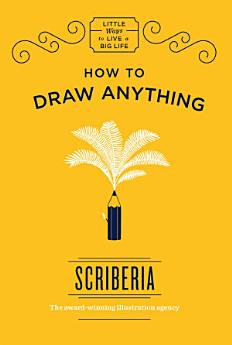How to Draw Anything
Scriberia
ছেপ্তে ২০১৭ · Hachette UK
৫.০star
২ টা পৰ্যালোচনাreport
ইবুক
64
পৃষ্ঠা
family_home
যোগ্য
info
reportমূল্যাংকন আৰু পৰ্যালোচনা সত্যাপন কৰা হোৱা নাই অধিক জানক
এই ইবুকখনৰ বিষয়ে
As children, when we learn to write, we gain an important life skill - a practical means of communicating that we end up using almost every day of our lives, if only to jot down a shopping list or dash out an email. As children, we also know instinctively that drawing is a great way to communicate, but later in life it isn't universally valued and nurtured in the way that writing is. It's not seen as a necessity, it's seen as a specialism.
As a result, most of us are robbed of a powerful, rewarding and perfectly achievable skill by a set of assumptions that are just plain wrong. In the 18th and 19th centuries drawing was central to a good education, not because we were training future artists, but because we were training future doctors, nurses, scientists, engineers, builders, cartographers, carpenters, plumbers and gardeners. We recognised the power of drawing to reveal, explain and clarify where words alone fell short. Florence Nightingale's visualisations of mortality data in the Crimean War saved many lives. From the scruffy sketchbook pages of Alexander Graham Bell came the first telephone. Charles Darwin grabbed a scrap of paper and mapped out the tree of life. They all understood that a good drawing is not one that is beautiful but one that does its job. Not a work of art, but art that works.
How to Draw Anything sets out to repair our broken relationship with drawing. Firstly, this book asks you to pick up that pencil from where you left it all those years ago and start making pictures again. It will give you back the confidence and joy in drawing you never should have lost. And secondly, How to Draw Anything will equip you with new means of solving problems, sharing ideas and telling stories. It will take drawing out of the art world and put it into your world, introducing you to drawing as a practical tool for everyday life that will change the way you work, think and communicate.
As a result, most of us are robbed of a powerful, rewarding and perfectly achievable skill by a set of assumptions that are just plain wrong. In the 18th and 19th centuries drawing was central to a good education, not because we were training future artists, but because we were training future doctors, nurses, scientists, engineers, builders, cartographers, carpenters, plumbers and gardeners. We recognised the power of drawing to reveal, explain and clarify where words alone fell short. Florence Nightingale's visualisations of mortality data in the Crimean War saved many lives. From the scruffy sketchbook pages of Alexander Graham Bell came the first telephone. Charles Darwin grabbed a scrap of paper and mapped out the tree of life. They all understood that a good drawing is not one that is beautiful but one that does its job. Not a work of art, but art that works.
How to Draw Anything sets out to repair our broken relationship with drawing. Firstly, this book asks you to pick up that pencil from where you left it all those years ago and start making pictures again. It will give you back the confidence and joy in drawing you never should have lost. And secondly, How to Draw Anything will equip you with new means of solving problems, sharing ideas and telling stories. It will take drawing out of the art world and put it into your world, introducing you to drawing as a practical tool for everyday life that will change the way you work, think and communicate.
মূল্যাংকন আৰু পৰ্যালোচনাসমূহ
৫.০
২ টা পৰ্যালোচনা
লিখকৰ বিষয়ে
Scriberia are an illustration agency based in London's King's Cross. They were selected by Pottermore to create a series of animated GIFs to launch the eighth Potter story, Harry Potter and the Cursed Child. Their other clients include Unilever, Mars, IBM, the Guardian, Oxfam, Goggle, ITV and Nespresso. They specialise in graphic facilitation, which is about harnessing the power of visual thinking to spark conversations, find solutions, invigorate passions and elevate ideas that might otherwise be lost or stagnant.
এই ইবুকখনক মূল্যাংকন কৰক
আমাক আপোনাৰ মতামত জনাওক।
পঢ়াৰ নির্দেশাৱলী
স্মাৰ্টফ’ন আৰু টেবলেট
Android আৰু iPad/iPhoneৰ বাবে Google Play Books এপটো ইনষ্টল কৰক। ই স্বয়ংক্রিয়ভাৱে আপোনাৰ একাউণ্টৰ সৈতে ছিংক হয় আৰু আপুনি য'তে নাথাকক ত'তেই কোনো অডিঅ'বুক অনলাইন বা অফলাইনত শুনিবলৈ সুবিধা দিয়ে।
লেপটপ আৰু কম্পিউটাৰ
আপুনি কম্পিউটাৰৰ ৱেব ব্রাউজাৰ ব্যৱহাৰ কৰি Google Playত কিনা অডিঅ'বুকসমূহ শুনিব পাৰে।
ই-ৰীডাৰ আৰু অন্য ডিভাইচ
Kobo eReadersৰ দৰে ই-চিয়াঁহীৰ ডিভাইচসমূহত পঢ়িবলৈ, আপুনি এটা ফাইল ডাউনল’ড কৰি সেইটো আপোনাৰ ডিভাইচলৈ স্থানান্তৰণ কৰিব লাগিব। সমৰ্থিত ই-ৰিডাৰলৈ ফাইলটো কেনেকৈ স্থানান্তৰ কৰিব জানিবলৈ সহায় কেন্দ্ৰত থকা সবিশেষ নিৰ্দেশাৱলী চাওক।




